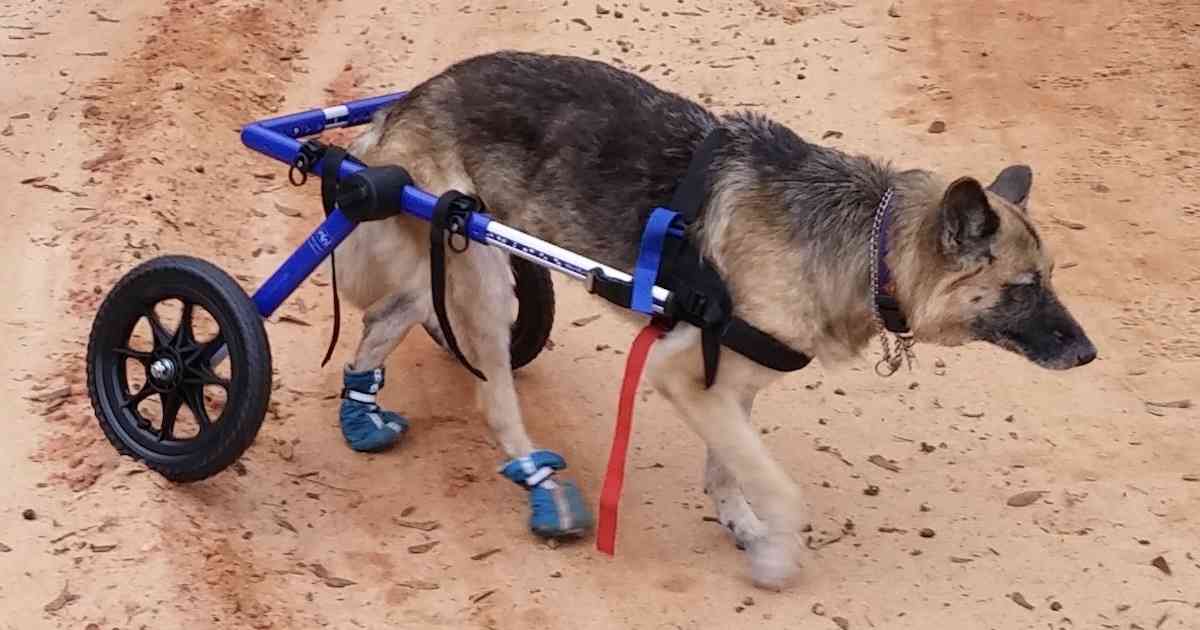Degenerative Myelopathy (DM) is a disease that affects the spinal cord of older dogs. It gradually leads to a loss of mobility and, eventually, paralysis. An article by the National Institutes of Health highlighted the case of a 9-year-old German Shepherd diagnosed with this condition. It emphasized the need for greater awareness and understanding of degenerative myelopathy.
What is Degenerative Myelopathy in Dogs?
Degenerative Myelopathy is a progressive neurodegenerative disease that specifically affects the spinal cord. As dogs get older, DM sets in to cause a gradual decline in their mobility. This disease targets the white matter in the spinal cord, which is responsible for transmitting nerve signals between the brain and the limbs. And unfortunately, there’s no cure for it.
When dogs develop degenerative myelopathy, they start experiencing a loss of coordination and muscle weakness. It usually begins in the hind limbs and gradually affects the front limbs of the dog. DM is often compared to amyotrophic lateral sclerosis in humans because they share similar symptoms and genetic foundations.

What are the Risk Factors for Degenerative Myelopathy?
Degenerative myelopathy doesn’t just affect dogs out of the blue. This condition is a result of poor choice or poor fortune.
Genetic Factors
The main reason why dogs develop Degenerative Myelopathy is due to a mutation in a gene called superoxide dismutase 1 (SOD1). Normally, this gene helps produce an enzyme that breaks down harmful substances called superoxide radicals. But when there’s a mutation in this gene, the enzyme doesn’t work properly and can’t effectively get rid of these harmful substances. As a result, the neurons in the spinal cord get damaged.
DM is inherited in a specific way called autosomal recessive. To actually develop the disease, a dog needs to inherit two copies of the mutated gene, one from each parent. Dogs who have only one copy of the mutated gene are known as carriers. They usually don’t show any symptoms themselves, but they can still pass on the mutated gene to their puppies. Genetic testing is a useful tool for breeders to identify which dogs are carriers or have DM.
Breeds at Risk
German Shepherds, Boxers, and Pembroke Welsh Corgis are the breeds that are most commonly affected by this condition. These breeds have a higher chance of having the SOD1 gene mutation, which makes them more prone to developing DM. Other breeds that are also at risk include Chesapeake Bay Retrievers, Rhodesian Ridgebacks, and Poodles. Although it’s less common, mixed-breed dogs can also get the disease.
Let’s take German Shepherds, for example. Studies have found that this breed might carry the SOD1 gene mutation. So they have a relatively higher chance of getting DM. The number of carriers in Pembroke Welsh Corgis is also quite high.
Diagnosis of Degenerative Myelopathy
Neurological Examination
When the vet checks out a dog, they’ll look at things like reflexes, muscle tone, coordination, and how the dog’s nervous system is working overall. They’ll do some specific tests, like the proprioceptive positioning test, where they put the dog’s paws in weird positions to see if the dog fixes them. This helps them figure out if the dog has any issues with sensing how its limbs are positioned.
Physical Examination Findings
The vet will be observing for any changes in the muscle flexibility of the dog. The vet will observe the walking position of the dog because DM will affect the way a dog walks in its initial stage. If the condition has already gone to the next stage, the vet might check for signs of muscle atrophy.
Genetic Testing
Genetic testing is a great test when diagnosing DM in a dog, and more so, in breeds that are most prone to the risk. They can simply draw blood, or use a cheek swab, then test the sample, to see if the patient carries the SOD1 gene. This test can let them know if the dog is a carrier or if it is affected by the disease.
Electromyography (EMG)
Another test that they might carry out is known as Electromyography. It records the electrical response of muscles in the body of the dog and can also give information on whether there is an irregularity that may imply damaged nerves. This helps the vet to distinguish DM from other diseases that cause similar signs. Generally, they perform this test when the dog is under anesthesia, and this yields a lot of information that concerns the nerves and muscles.
Cerebrospinal Fluid (CSF) Analysis
Cerebrospinal Fluid Analysis is a test where they collect a sample of the fluid around the brain and spinal cord. This can help them figure out if there’s any inflammation or infection that might be causing symptoms similar to DM. Usually, they’ll do this test when the dog is under general anesthesia, and they have to be really careful with how they handle the sample to avoid any complications.
Treatment and Management of Degenerative Myelopathy
Just so you know, there isn’t currently a cure for Degenerative Myelopathy. But don’t worry, there are medications that can help manage the symptoms and improve your quality of life.
You’ve got non-steroidal anti-inflammatory drugs (NSAIDs), which can reduce inflammation and pain. And then there are immunosuppressants that may slow down the progression of the disease.
Now, let’s talk about some exciting developments in the field. Researchers are actively working on new treatments for DM. They’re exploring gene therapy, which aims to fix the genetic mutation responsible for DM. And there’s also stem cell therapy, which tries to regenerate damaged nerve cells in the spinal cord.
Physical Therapy
Regular exercise is very important for maintaining muscle strength and flexibility. It can help slow down muscle atrophy. Hydrotherapy is a great option too. It lets dogs exercise with less strain on their joints, which means less pain. Oh, and we can’t forget about massage therapy. It’s great for relieving muscle tension and improving circulation.
Mobility Aids
When it comes to mobility, there are wheelchairs specifically designed for dogs to provide support and keep them moving. Harnesses can also come in handy for lifting and supporting dogs.
Pain Management Strategies
Pain management is also essential. Besides NSAIDs, there are other strategies to consider. Physical therapy, acupuncture, and alternative therapies like laser therapy can help reduce discomfort and improve your quality of life.
Conclusion
Degenerative Myelopathy is a tough disease that affects both dogs and their owners deeply. While there’s no cure yet, advancements in genetic research, early diagnosis, and supportive treatments give us hope for improving the quality of life of affected dogs.
For more information on keeping your dog healthy, check out VetGen Pharmaceuticals blog.






